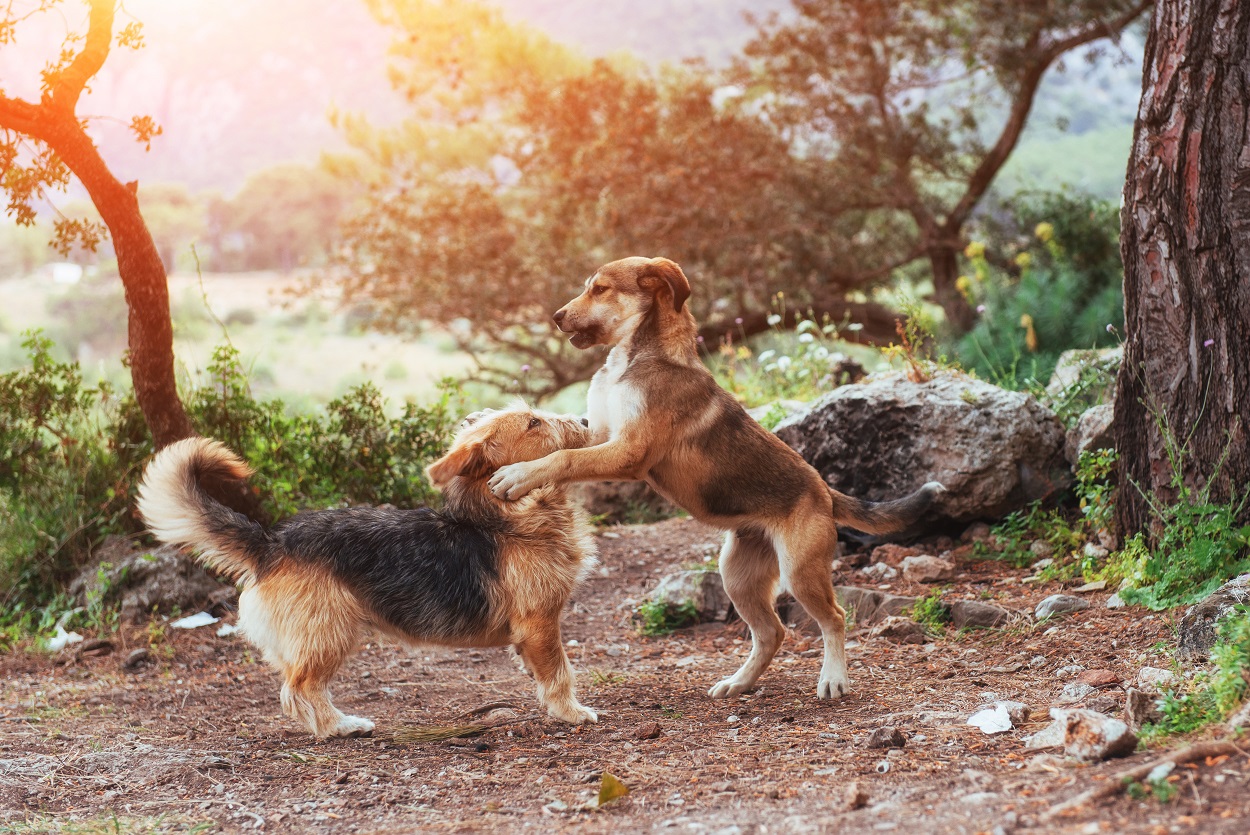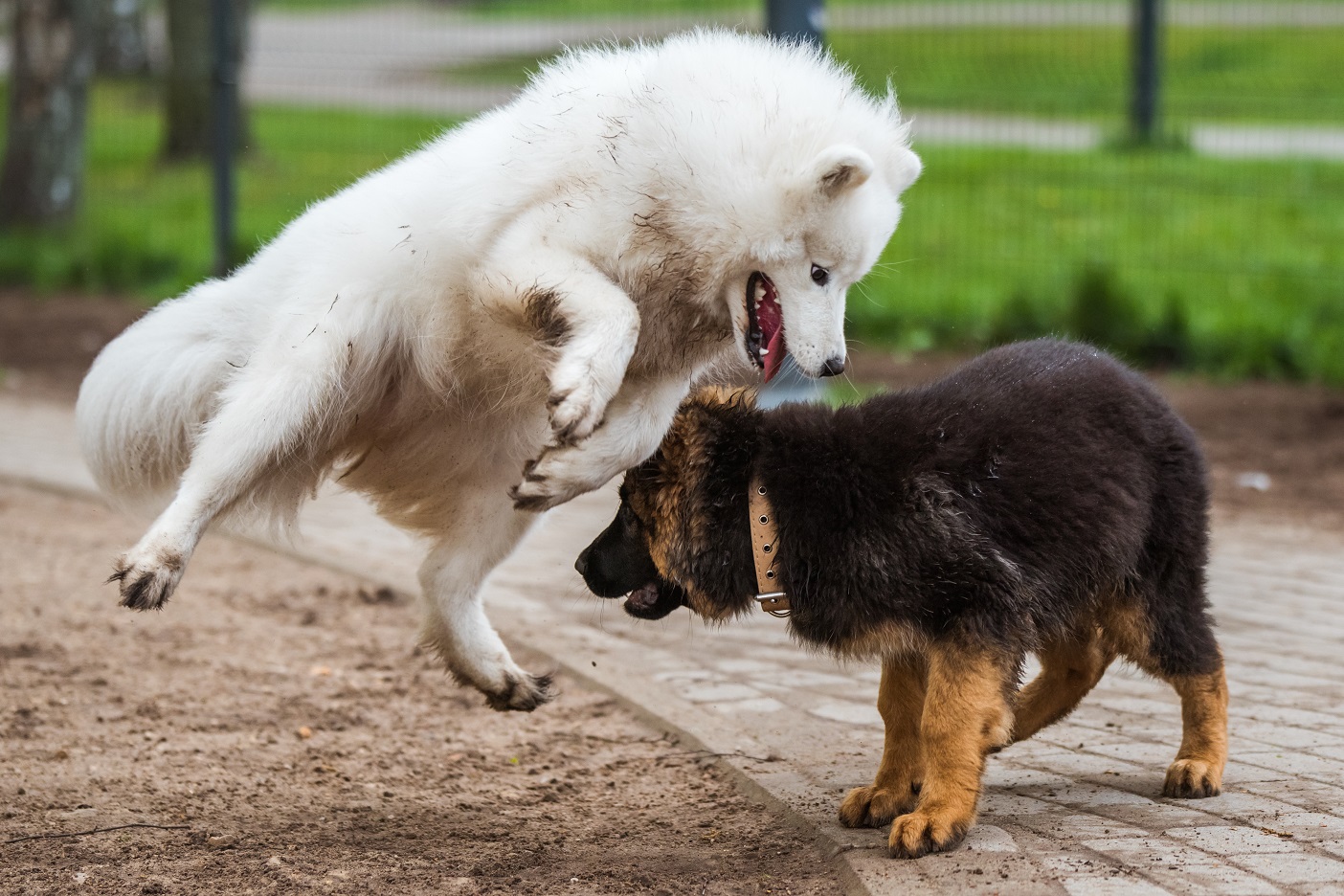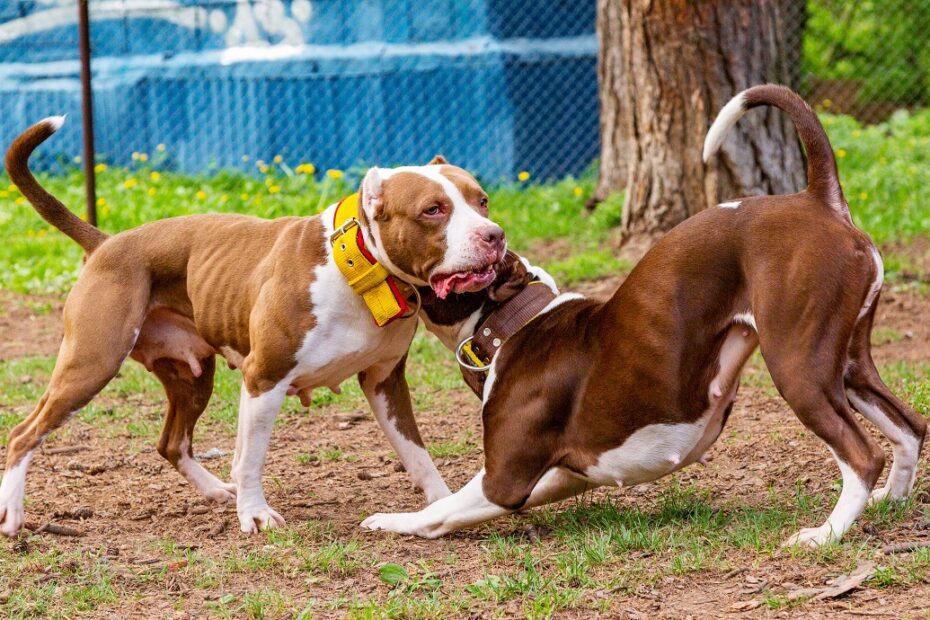I remember a few years back when I started to notice my dog biting other dogs ears.
And while the whole fiasco seemed innocent enough (after all, dogs love to have the occasional nibble). Over time, it seemed that the usual rough play that my dog was engaging in was starting to border on aggression.
Not only that, but the behavior was becoming more and more frequent to the point where I eventually had to intervene.
Now, there’s a very fine line between biting for fun and biting with aggressive intent. And it’s ultimately our job as owners to keep a close watch to make sure it isn’t the latter.
And if yourself in a similar situation, then I know how you feel. I also know how difficult it is to keep under control, especially if you’re used to your dogs getting along.
So what did I do?
Well, in this particular situation, I did what most people would and did a quick google search to see if I could find any way to stop my dog’s unwanted biting.
A lot of websites seemed to teach the same old, rehashed information. While some even stated that I should just ignore the behavior and just hope it goes away (not a chance).
But eventually, I came across an interesting dog trainer called Dan Abdelnoor, who ran a video-based membership site called The Online Dog Trainer.
Better still, he was offering a 3 day trial of his entire training platform for the low, low price of one dollar.
Now, I often get kind of skeptical about buying into these kinds of things because I’ve been burned before.
But the offer seemed genuine enough, and I eventually came to the conclusion that in the worst-case scenario, I’d lose a dollar and maybe a few hours out of my day.
So I paid the dollar and quickly began implemented some of the initial calming exercises Dan recommended in a desperate attempt to restore control over my dogs.
Long story short, Dan gets my A+ seal of approval as some of the techniques I’ve learned have literally been a godsend when it comes to keeping the peace between my dogs.
Anyway, I can only speak from personal experience here. And can’t guarantee that you’ll get the same if any benefits from Dan’s training.
But if you’re hell-bent on nipping your dog’s unwanted biting habits in the bud (no pun intended). Then I’d highly recommend taking a few minutes to check out Dan’s Official Website over at The Online Dog Trainer by hitting the video link below.
(video will open in a new window)
Why Does My Dog Bite Other Dogs Ears?
Now, dogs bite; that’s a fact. But understanding why is the first step to getting it under control.
Again, sometimes biting can be of a playful nature, and this is totally fine.
But other times, it can slip its way into the unwanted type of biting that can end with an emergency trip to the vet.
So allow me to take a few minutes to highlight some of the more common reasons your dog may be biting other dogs’ ears.
Take note and see if anything looks familiar…
Overexcitement
Dogs love to play, and while a little harmless mouthing and nipping can be innocent enough. Too much overexcitement can often lead to things taking a turn for the worst.
It’s kinda like when too many parents get together and let their kids run wild. Even though you know it’s not intentional, you know that eventually, someone’s going to get hurt.
And it’s exactly the same with dogs.
Rough Play
Similar to overexcitement, rough play is very common among dogs, especially in more dominant breeds.
Sometimes, however, things can get a little too rough if one dog pushes the boundaries or rough play and ends up taking things a little too far.
The end result?
…A very unhappy dog with a very sore ear.
Dominance
The constant battle for hierarchy and pack leadership is enough for any dog to take things a little too far.
Although this isn’t the case for all dogs, others thrive on dominant displays of aggression to ascertain that they are, in fact, top dog.
As you can imagine, this can become quite a handful to deal with, especially if you have two dogs fighting it out for the position of ‘leader of the pack.’
Territorial/Possessivness
Dogs can become territorial or possessive for all sorts of reasons. Resource guarding, possessiveness over food or toys… you name it.
Even you can be seen as a possession if your dog deems it to be so.
And it’s this same possessive behavior that can ultimately cause your dog to have a biting frenzy if they think another dog’s trying to take what’s rightfully theirs.
Dislike
Let’s face facts, not all dogs are going to get on, and it’s unreasonable for us to think otherwise.
Just like humans, dogs will often have a difference of opinion. Whether it’s what toys to play with, which food bowl is theirs…
…Even sleeping arrangements such as who gets the comfy dog bed is always going to be on the agenda when it comes to getting what they want.
In addition to this, dog breeds that are equally dominant are always going to find one or more reasons to challenge the other to prove that they are the superior ‘Alphha’ dog.
And while it can seem a little immature from where we stand, it’s ultimately what makes some dogs tick.

The Difference Between Playful & Aggressive Biting
Sometimes spotting the difference between playful and aggressive biting is relatively straightforward.
For instance, the dog on the receiving end yelps out in pain, then it doesn’t take a scientist to realize that things may have gone a little too far.
But how do you tell the difference between aggression and play when the signs aren’t so obvious.
Here’s what you should look out for…
Playful Biting
Nine times out of ten, playful biting isn’t really biting at all. Normally, it’ll just involve general mouthing or nipping of the other dog’s ears and won’t be something to get too concerned about.
Usually, these types of playful bites will be accompanied by a relaxed posture and even a wagging tail.
Even if it seems a little rough, these are all clear indicators that aggression isn’t on the menu, and you should breathe a sigh of relief.
Just be sure to keep a close watch and possibly intervene if things seem to be getting a little more heated.
Aggressive Biting
Aggressive behavior is usually more frantic as, most of the time, it’s your dog’s intent to cause some real damage.
Body language normally a great indicator of aggressive behavior, but sometimes the signs aren’t so obvious, so make a note of the following and see if anything looks familiar…
- Does your dog demonstrate a low or deep growl that’s longer in duration?
- Do they have a rigid posture, or are their eyes fixated on the other dog?
- Are they baring their teeth?
If you spot any of the above, act ASAP and separate your dog from any more interaction before things get out of hand.
Now might also be a good time to visit Dan’s website, The Online Dog Trainer, and check out those 5 step-by-step calming exercises I was talking about earlier as well.
Because if you’re looking for an effective way to dial down your dog’s aggressive emotions and bring about a little calm. This is by far the best way to do it.
Related Post: Why Is My Dog Being Aggressive All Of A Sudden?

How To Stop Your Dog Biting Other Dogs Ears
Before diagnosing how to stop your dog biting other dogs’ ears, you first need to establish if it’s a real issue.
Again, the odd playful nibble isn’t too much cause for concern, but it should still be discouraged if your dog seems to be taking things a little too far.
At the end of the day, you know your dog better than anyone else. So it’s ultimately in your capable hands to make a sensible judgment call on what is and isn’t acceptable.
And once you make this decision, stick with it. There’s no point discouraging the behavior one day and then allowing it the next. As this will only confuse your dog and render all of your previous efforts useless.
Figure Out What’s Causing It
The first step towards dealing with any behavioral issue? …Figure out what’s causing it.
Really pay close attention here too, because if you can figure out why it’s happening, you’ll be in a much better position to stop it from happening in the future.
So ask yourself the following…
- Which dog is causing the issue
- Where is it happening (on walks, in specific places, or around particular people of dogs)
- When is it happening (mealtimes, bedtime, etc…)
You really need to consider all of the options here because if you can figure out a regular pattern as to why it’s happening. You’ll be in a better position to either try and avoid those particular situations. Or better still, put into action an effective plan to address it.
For instance, if you happen to notice aggressive ear-biting in a specific room or around a particular person. You’re dog could be demonstrating territorial instincts and attempting to defend what they feel is rightfully theirs.
Separate And Monitor
Once you’ve established a route cause, now’s the time to try a little separation from these specific interactions to see if the problem persists.
Sometimes this will be more difficult than others, but it’s important to do your best nonetheless.
For instance, if you notice your dog biting your other dog’s ears around mealtimes. Consider separating their bowls and let them eat in different rooms. Or even at different times during the day.
Doggy gates can often be a useful tool for these kinds of situations, and although it might seem a little overkill at first. It will confirm if your initial suspicions about why your dog is biting to be correct.
Distract
Distraction techniques can work well as either a pre distraction technique or to stop your dogs in the middle of a scuffle.
So next time you notice the all to familiar sight of your dog about to jump in for a quick nibble or bite. Simply make a short sharp sound like a loud clapping noise or banging metal on metal.
If you have one to hand, an air horn is a great distraction technique to take your dog out of the aggressive zone.
Use sparingly though, as you probably won’t be thought of too kindly by the neighbors by blasting an air horn every 30 seconds.
Another quick yet very effective technique you can use is to simply throw a blanket or even a large towel over your dog as a visual distraction.
You’d be surprised at how well this can work, and it also gives you time to remove your dog from the situation before all hell breaks loose.
Teach Them To Be Calm
Calming techniques work great for overly aggravated dogs.
They’re also a great way to teach your dog emotional control, which in turn will help them naturally calm their aggressive tendencies in any situation that may trigger it.
Again, this is why I’d always recommend implementing the 5 step-by-step calming exercises into your dog’s routine on a regular basis to see a permanent change in their behavior for the better.
And while not an overnight fix for unwanted ear-biting. I think you’d be surprised at how a few simple exercises that take only minutes a day can have a long-term effect on your dog’s physical and mental wellbeing.
Related Post: How To Calm An Aggressive Dog – Simple Tips For Aggressive Behavior

Wrapping Things Up
So before we wrap things up, let’s just quickly recap on some of the more important points of this post.
Firstly, it’s essential that you understand why your dog bites as well as being able to spot tell-tale signs between both playful and aggressive biting.
Second, figuring out the root cause is a must if you want any chance of getting to the bottom of the issue.
You can then go ahead and use specific techniques like temporary separation and distractions to get the situation under control.
And lastly, you should teach your dog how to be in control of their emotions for a long-term solution to the problem.
Again, the 5 step-by-step calming exercises discussed will work wonders for here. So make sure to take a look before hitting the back button on this page.
At the end of the day, biting can be a pain in the proverbial, especially if you don’t know how to manage it effectively.
But by following the above advice and, more importantly, taking consistent action, you’ll be well on your way to a calmer (non-emotional) dog a lot sooner than you think.

